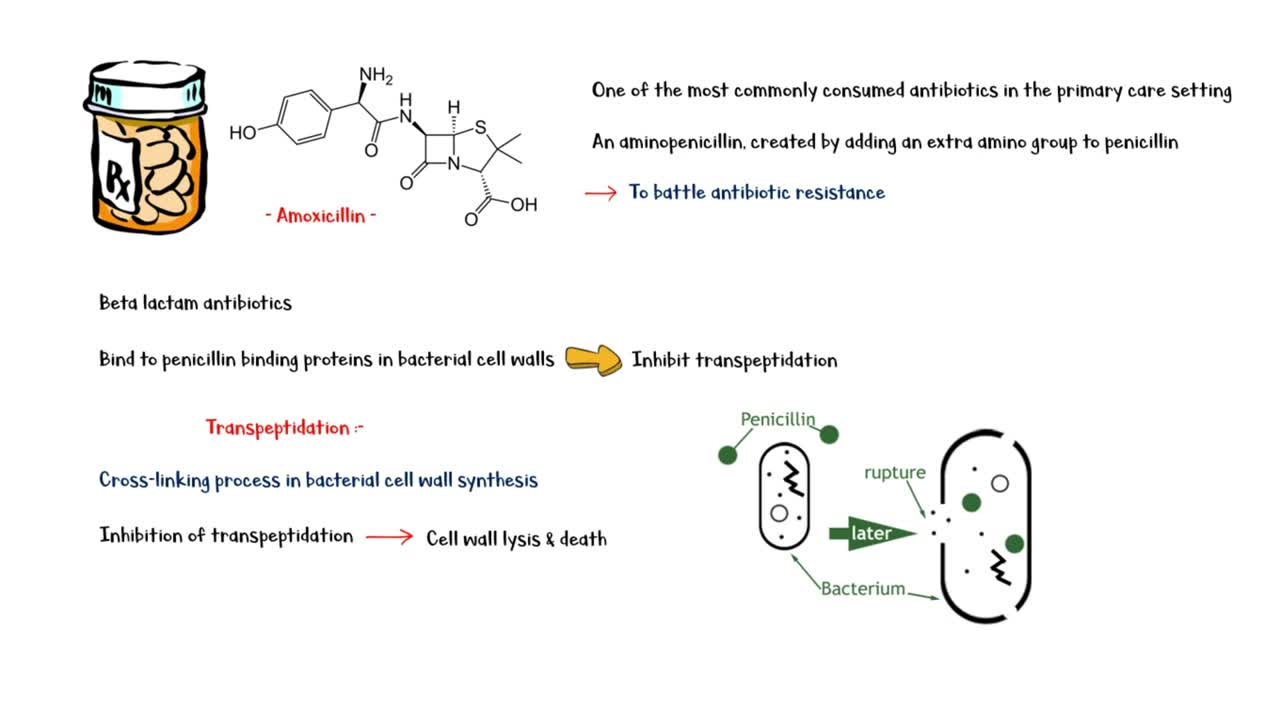Premium Only Content

Amoxicillin - Uses, Mechanism Of Action, Coverage, Adverse Effects _Everything You Need To Know
Amoxicillin is one of the most commonly consumed antibiotics in the primary care setting. It is an amino penicillin created by adding an extra amino group to penicillin to battle antibiotic resistance. Amoxicillin belongs to the class of beta lactam antibiotics. They act by binding to the penicillin binding proteins in bacterial cell walls, and inhibiting a process called transpeptidation. Transpeptidation is the cross linking process of peptides during bacterial cell wall synthesis and it is essential for the replication & survival of bacteria. So, inhibition of transpeptidation leads to cell wall lysis and death of the bacteria. This type of action is called the bactericidal activity since bacteria get killed by the antibiotic.
Amoxicillin covers a wide variety of gram positive bacteria, with some additional gram negative coverage compared to standard penicillins. Like penicillin, it covers most streptococcus species, and is also effective against listeria monocytogens, and enterococcus species. It also covers Hemophilus influenzae, E coli, Actinomyces species, clostridium species, salmonella, shigella, and Corynebacterium species.
FDA approved indications of amoxicillin include the following.
Ear, nose, and throat infections such as tonsilitis; pharyngitis; and otitis media.
Helicobacter pylori eradication therapy in gastritis.
Acute bacterial sinusitis.
Skin infections.
Urinary tract infection.
And post exposure prophylaxis foe anthrax.
Off label uses of amoxicillin include the following.
Lyme disease, if doxycycline is contraindicated.
Prophylaxis for infective endocarditis.
Periodontitis, in combination with metronidazole.
And actinomycosis.
Bactericidal antibiotics like amoxicillin are most effective when given in a time dependent manner rather than a concentration dependent manner. Time dependent refers to the time that serum concentrations of the drug exceed the minimal inhibitory concentration for the micro organism. Therefore, these drugs are dosed more frequently.
Amoxicillin is only taken per orally. It is available in immediate and extended release tablets. It also comes as a chewable tablet or a suspension. Common adverse effects of amoxicillin include the following. Gastrointestinal disturbances such as nausea and vomiting, and diarrhea. Superinfection, especially with candida species and clostridium difficile. Nephrotoxicity.
Hepatotoxicity.
And hypersensitivity reactions like rash, and in more serious situations, anaphylactic shock.
Amoxicillin is considered to be safe in pregnancy and breastfeeding.
#Amoxicillin #AmoxicillinUses #AmoxicillinSideEffects
-
 2:51:50
2:51:50
Laura Loomer
4 hours agoEP156: Trump Sounds The Alarm On The Nigerian Christian Genocide
27.9K33 -
 1:11:27
1:11:27
Flyover Conservatives
23 hours agoDAVID GREEN: “God Owns It All”: How Hobby Lobby Thinks About Money, Time & Eternity w/ Bill High | FOC Show
16K2 -
 LIVE
LIVE
DLDAfterDark
2 hours ago $0.96 earnedThe Armory - God, Guns, and Gear - A Conversation About Preparedness
436 watching -
 23:42
23:42
Robbi On The Record
3 hours ago $1.86 earnedMAGA 2.0? BTS of Michael Carbonara for Congress
18.7K3 -
 LIVE
LIVE
Drew Hernandez
22 hours agoSHAPIRO COOKS HIMSELF: SAYS YOU DON'T DESERVE TO LIVE WHERE YOU GREW UP?
973 watching -
 1:59:26
1:59:26
Barry Cunningham
5 hours agoLIVE WATCH PARTY: J.D. VANCE ON THE SEAN HANNITY SHOW!
26.4K16 -
 2:11:15
2:11:15
megimu32
4 hours agoOFF THE SUBJECT: Judging Strangers on Reddit 😭 PLUS! Fortnite Chaos!
21.4K5 -
 2:53:16
2:53:16
Mally_Mouse
3 days ago🎮 Throwback Thursday! Let's Play: Stardew Valley pt. 32
31.4K1 -
 28:25
28:25
ThisIsDeLaCruz
13 hours ago $2.44 earnedInside the Sphere Part 2: Kenny Chesney’s Vegas Stage Revealed
13.5K -
 LIVE
LIVE
Lofi Girl
2 years agoSynthwave Radio 🌌 - beats to chill/game to
191 watching